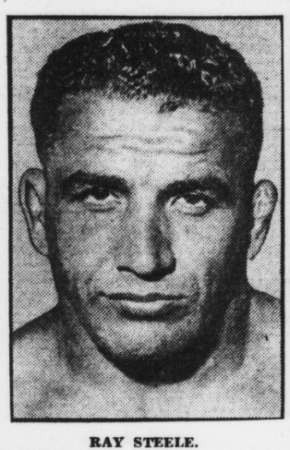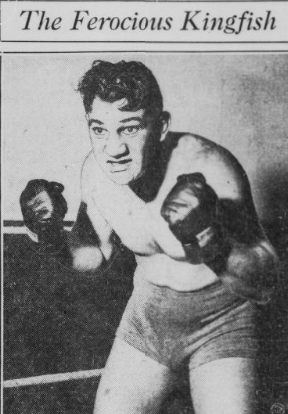Steele Faces Levinsky in Mixed Bout
On November 19, 1935, professional wrestler Ray Steele met professional boxer Kingfish Levinsky in a mixed wresting versus boxing bout. The Missouri State Athletic Commission created special rules for the match.
The commissioners ruled the bout would consist of three-minute rounds like a boxing match. The commissioners allowed Levinsky to punch even if he was on the mat. Steele could not butt, gouge, or pull Levinsky’s hair. To win, Steele would pin Levinsky to the mat for 10 seconds or make him quit. Levinsky could knockout Steele or the referee could stop the contest for a technical knockout (TKO).

Photo of Ray Steele courtesy of the Library of Congress (Public Domain)
Physically, the men were evenly matched. Levinsky stood five feet, eleven inches tall. Steele was only an inch taller at six feet even. Both men weighed 205 pounds.
Levinsky was only 25 years old. Steele was 10 years older at 35 years of age. Levinsky was a solid professional, but Steele was one of the most feared submission wrestlers in professional wrestling.
In most mixed style bouts, the grappler usually has an advantage over the striker. For most strikes to be effective, the striker wants to hit his or her opponent at the end of their power, when the arms and legs are almost fully extended. Once the grappler takes the striker off their feet, they are usually helpless. A good modern example is the mixed martial arts (MMA) bout between Randy Couture and James Toney at UFC 118.
Not all mixed bouts ended like that match. Big Sam McVey engaged in a mixed styles bout with a JuJitsu fighter in Europe during the 1910s Sam McVey knocked his opponent out in under 10 seconds.
In most bouts, the wrestler or grappler had the advantage though. Ray Steele continued the trend.
The men met at St. Louis’ Arena in front of 11,262 spectators. Levinsky told anyone, who would listen, that a professional boxer could beat any wrestler. He would soon find himself eating his words.
Referee Walter Heisner signaled for the bout to start. Levinsky came out of his corner and hit Steele with a left hook to the head and missed with the follow-up right. Steele secured a waist hold, slid to Levinsky’s back and started to lift him off the mat. Levinsky hooked the top rope with his left arm and held on for dear life.

Photo of Kingfish Levinsky courtesy of the Library of Congress (Public Domain)
Steele jerked Levinsky off his feet to dislodge him from the rope, but Levinsky would not release his death grip. Heisner broke the men and restarted the match in the center of the ring.
Levinsky scored with a right cross, left hook combination that staggered Steele for a second. Steele regained his senses, charged into Levinsky, and knocked him down. Steele used a simple body lock to hold Levinsky down for the count of ten as Levinsky flailed weak punches with his right hand. Steele won the match in 35 seconds.
The fans did not riot because they had seen four wrestling matches and three boxing bouts before the main event. The fans cheered the wrestling matches but seemed bored by the boxing bouts.
The fans paid between forty cents and $2.50 for a gate of $11,103. The special exhibition drew a big crowd and lucrative grate.
Walter W. Smith of the St. Louis Star-Times interviewed Levinsky after the bout. Smith asked him what he thought of Steele? Levinsky replied, “Strong.”
Smith asked Levinsky if a good boxer could still beat a good wrestler? “Yes” Levinsky replied. “No” his brother Sam Levinsky corrected.
Steele only had a red mark by his right eye from Levinsky’s left hand. Smith asked Steele if he had been hurt? “Nah.” It was another day at the office for Ray Steele.
You can leave a comment or ask a question about this or any post on my Facebook page or Twitter profile.
Source: St. Louis Star and Times, November 20, 1935 edition, p. 24

